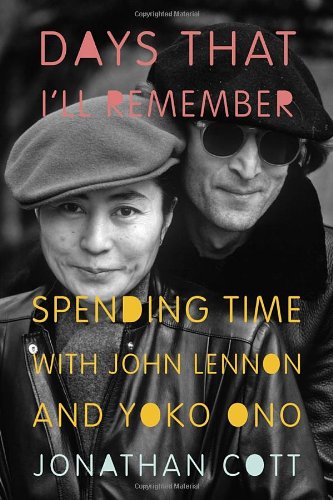
Synopsis
A deeply personal memoir of time spent with John Lennon and Yoko Ono, Cott's account begins with his first meeting of the world-famous couple in their basement flat in London, as a graduate student on a Fulbright where he was also serving as the "London editor" of a small rock magazine named Rolling Stone. The next day he was invited by Lennon to watch the recording of "Glass Onion" and "Birthday" at Abbey Road Studios. A connection was formed that lasted until Lennon's death - with Cott formally interviewing him again days before he was killed. Cott has also remained close friends with Yoko One. It is a fascinating and intimate reminiscence filled with Cott's insights as a cultural critic and journalist along with portions of the 1968 and 1980 interviews which will be transcribed within our book for the first time.
Les informations fournies dans la section « Synopsis » peuvent faire référence à une autre édition de ce titre.
À propos de la quatrième de couverture
A deeply personal memoir of time spent with John Lennon and Yoko Ono, Cott's account begins with his first meeting of the world-famous couple in their basement flat in London, as a graduate student on a Fulbright where he was also serving as the "London editor" of a small rock magazine named Rolling Stone. The next day he was invited by Lennon to watch the recording of "Glass Onion" and "Birthday" at Abbey Road Studios. A connection was formed that lasted until Lennon's death - with Cott formally interviewing him again days before he was killed. Cott has also remained close friends with Yoko One. It is a fascinating and intimate reminiscence filled with Cott's insights as a cultural critic and journalist along with portions of the 1968 and 1980 interviews which will be transcribed within our book for the first time.
Les informations fournies dans la section « A propos du livre » peuvent faire référence à une autre édition de ce titre.
Autres éditions populaires du même titre
Résultats de recherche pour Days That I'll Remember: Spending Time With John...
Days That I'll Remember: Spending Time with John Lennon and Yoko Ono
Vendeur : World of Books (was SecondSale), Montgomery, IL, Etats-Unis
Etat : Very Good. Item in very good condition! Textbooks may not include supplemental items i.e. CDs, access codes etc. N° de réf. du vendeur 00084299249
Acheter D'occasion
Quantité disponible : 3 disponible(s)
Days That I'll Remember: Spending Time with John Lennon and Yoko Ono
Vendeur : World of Books (was SecondSale), Montgomery, IL, Etats-Unis
Etat : Good. Good condition ex-library book with usual library markings and stickers. N° de réf. du vendeur 00087567974
Acheter D'occasion
Quantité disponible : 1 disponible(s)
Days That I'll Remember: Spending Time with John Lennon and Yoko Ono
Vendeur : Wonder Book, Frederick, MD, Etats-Unis
Etat : Very Good. Very Good condition. Very Good dust jacket. A copy that may have a few cosmetic defects. May also contain light spine creasing or a few markings such as an owner's name, short gifter's inscription or light stamp. N° de réf. du vendeur T00A-03912
Acheter D'occasion
Quantité disponible : 1 disponible(s)
Days That I'll Remember : Spending Time with John Lennon and Yoko Ono
Vendeur : Better World Books: West, Reno, NV, Etats-Unis
Etat : Good. Former library book; may include library markings. Used book that is in clean, average condition without any missing pages. N° de réf. du vendeur 2304608-6
Acheter D'occasion
Quantité disponible : 1 disponible(s)
Days That I'll Remember : Spending Time with John Lennon and Yoko Ono
Vendeur : Better World Books, Mishawaka, IN, Etats-Unis
Etat : Very Good. Former library book; may include library markings. Used book that is in excellent condition. May show signs of wear or have minor defects. N° de réf. du vendeur GRP102244299
Acheter D'occasion
Quantité disponible : 3 disponible(s)
Days That I'll Remember: Spending Time with John Lennon and Yoko Ono
Vendeur : ThriftBooks-Atlanta, AUSTELL, GA, Etats-Unis
Hardcover. Etat : Very Good. No Jacket. Former library book; May have limited writing in cover pages. Pages are unmarked. ~ ThriftBooks: Read More, Spend Less. N° de réf. du vendeur G0385536372I4N10
Acheter D'occasion
Quantité disponible : 1 disponible(s)
Days That I'll Remember: Spending Time with John Lennon and Yoko Ono
Vendeur : Goodwill Books, Hillsboro, OR, Etats-Unis
Etat : acceptable. Fairly worn, but readable and intact. If applicable: Dust jacket, disc or access code may not be included. N° de réf. du vendeur 3IIT4R004EYC_ns
Acheter D'occasion
Quantité disponible : 1 disponible(s)
Days That I'll Remember: Spending Time with John Lennon and Yoko Ono
Vendeur : Half Price Books Inc., Dallas, TX, Etats-Unis
hardcover. Etat : Very Good. Connecting readers with great books since 1972! Used books may not include companion materials, and may have some shelf wear or limited writing. We ship orders daily and Customer Service is our top priority! N° de réf. du vendeur S_391001916
Acheter D'occasion
Quantité disponible : 1 disponible(s)
Days That I'll Remember: Spending Time with John Lennon and Yoko Ono
Vendeur : HPB-Ruby, Dallas, TX, Etats-Unis
Hardcover. Etat : Very Good. Connecting readers with great books since 1972! Used books may not include companion materials, and may have some shelf wear or limited writing. We ship orders daily and Customer Service is our top priority! N° de réf. du vendeur S_433073594
Acheter D'occasion
Quantité disponible : 1 disponible(s)
Days That I'll Remember: Spending Time with John Lennon and Yoko Ono
Vendeur : Academybookshop, Long Island City, NY, Etats-Unis
Hardcover. Etat : Very Good. Fine, clean condition, this book is new but is without dust-cover, clean pages *** Hard-bound ***. N° de réf. du vendeur A-16167
Acheter D'occasion
Quantité disponible : 1 disponible(s)

